Understanding Gamers through Belly Laughs: Knights of the Dinner Table by Jolly R. Blackburn
Three issues of Jolly Blackburn’s long-running
Knights of the Dinner Table, all shipped simultaneously: #273, 274, & 275
The COVID-19 pandemic has played havoc with virtually every aspect of life around the globe. That was driven home to me (again) when three issues of my Knights of the Dinner Table subscription were delivered in a single envelope last week.
Given all the upheaval the world has gone through in just the last five months, it was an eerie look into the recent past to open the first of them, issue #273 (planned on-sale date: May 2020) and read Jolly R. Blackburn’s editorial, written in March 2020 and titled “And Just Like That — Everything Changes.” Children of the Apocalypse, gather round and read these words from the long ago before-time:
Hey folks — I hope this finds each of you reading this, healthy, safe and doing well. Clearly, with what has transpired in recent weeks, that is most certainly not the case for everyone. Many of you have likely lost loved ones, are sick, unemployed, wondering what the future will bring or all of the above. This is indeed something that has left no one untouched.
I [know] that Knights of the Dinner Table has always been a refuge of sorts from the hard realities of the real world. Readers come here to forget their worries, have a laugh, possibly be touched and celebrate the love of rolling dice and gaming with friends. That won’t change… we’re all in this together, despite differences.
As I write this, there is a lot going on. The nation is in a state of self-isolation and shut down. I wanted to tell you what that means for KenzerCo and the Knights even though in the grand scheme of things, it might be the last thing on your minds. We are fortunate in that we are a small company with our own warehouse and shipping facility. Barb and I continue to ship product twice a week and can do so without interacting with others. So we are completely safe in doing so.
Here’s the glitch. Our distributors recently announced they will NOT be shipping product to retailers until this is all over. Which is understandable because many game and comic shops are currently shutting down and there’s no place to ship product to.
On top of that, the printer who publishes our monthly deadtree issues is in a shutdown also!
Take it from me: It’s tough to keep a monthly magazine going when both your printer and your distributors cease operations. But Jolly and team battened down the hatches and did it, producing digital issues, and getting them out to subscribers, on time. And when their printer opened up again they did a bulk run of all three issues, shipping them to subscribers as quickly as possible. Getting all three at once allowed me to read the issues back-to-back, and re-appraise just what it is that Jolly is doing, and how much it’s impacted the hobby.
[Click the images for Dinner Table-sized versions.]
A better question is why, indeed. Sara is right — this isn’t going to end well
It’s not an exaggeration to say that Jolly’s Knights of the Dinner Table is one of the most important and singular creations to emerge out of the American gaming scene in the 20th Century. Originally created as a backup feature in the second issue Jolly’s gaming magazine Shadis (March/April 1990) to fill a blank page, it quickly became the most popular strip in the industry, prominently featured in Shadis, Dragon magazine, and eventually its own magazine beginning in 1994.
KoDT began as a simple one or two-page gag strip featuring a group of myopic, greedy-for-experience-points gamers and their out-of-his-depth Dungeon Master B.A, constantly frustrated as he tries to teach them the error of their (usually disastrous) ways. The group’s never-ending antics, and B.A’s mounting despair, fuel the comedy and are instantly familiar to anyone who’s role played at a table with other gamers. Eventually the strips grew to accommodate longer, more character-focused stories, and the cast of characters has expanded to encompass a diverse array of interesting and quirky gamers, gaming professionals, and their assorted family members and loved ones.
Knights of the Dinner Table (KoDT) has been honored with virtually every major award the industry has to offer, including the Origins Awards for Best Professional Game Magazine (1998, 1999), the Origins Award for Best Game Accessory (2009), and the Origins Award Gamer’s Choice Best Periodical (2003). It is one of the longest-running independent comics in American history, rapidly closing in on 300 issues (at which point it will surpass Dave Sim’s Cerebus, which was once the longest-running independent comic.)
But they fall for it anyway
More than that, the cast and characters of KoDT have sunk deep into American gaming culture, and enjoy celebrity status. Twenty-three years ago, after being laid off from my start-up job in Chicago, I drove through the snow for three hours to attend Winter War in Champaign, Urbana. One of my clearest memories of that long-ago con is sitting in the front row as they set up for the gaming auction, and listening as gamers (and organizers) compared their characters to Bob, Dave, Brian, and other beloved characters from KoDT, and realizing that everyone in the audience knew immediately who they were talking about.
Many of the most popular KoDT strips — such as the gang’s horrifying encounter with a gazebo, the famous Bag Wars Saga (triggered when Sergeant Barringer and other hirelings, unceremoniously stuffed into a Bag of Holding for easy transport, finally rebel, building a pocket fortress and commandeering the group’s precious supplies), and the Cattlepunk Chronicles — have achieved legendary status among gamers. They are favorite tales that anyone who has played in a large group (or at a convention) has heard retold or referenced countless times, the ways non-gamers refer to their favorite episodes of Friends and Star Trek.
I’ve lost count of the many ways KoDT has influenced American gaming culture. There are board games inspired by the strip (Orcs at the Games), card games (Hack!), spin-off comics (Knights of the Dinner Table Illustrated), and even in ill-fated attempt at a live-action TV series. HackMaster, a fictional role playing game the group plays obsessively, was turned into a popular RPG by KenzerCo in 2001. It won the Origins Award for Game of the Year 2001 and has gone through multiple editions, most recently in 2011 (Fifth Edition.)
Weird Pete gives Dave some hard-earned gaming insight. And is promptly ignored.
Over the decades creator Jolly Blackburn has refined his craft significantly, telling more ambitious stories that draw from a deep understanding of gaming culture. But he’s never lost his ability to get a belly laugh.
While Jolly has brought a lot more artistic tools to bear to tell his stories, he’s kept his character renderings simple, just one notch above stick figures. Surprisingly, this works well. The deceptively simple character art lowers your defenses. The strip has no overt pretensions, and in fact looks like something drawn by your gaming buddies. The simple character renderings disguise the level of artistic craft and design that go into the background and layout.
Jolly has never claimed to be an artist, and in truth the art isn’t where this strip shines anyway. Jolly’s true gifts are as a writer, and the writing in KoDT is top notch. Jolly has a gift for laying down true insights in front of his characters — like Weird Pete telling Dave the secret to being a truly great game master is to wing it, and let the players dictate events — only to have them talked over by a frustrated cast who have no time for advice. Like King Lear or Kramer on Seinfeld, they’re barrelling towards a fate of their own making.
Patty and B.A. are the astute observers of the group
While making the issues available to subscribers on schedule in PDF format was a splendid idea, I prefer to read comics the old fashioned way: squinting at the pen-and-ink pages in my big green chair, wishing the font were bigger.
Still, the opportunity to read these issues back-to-back gave me a fresh appreciation for what Jolly has been doing recently. If it’s been a few years since you’ve enjoyed the adventures of the Knights, or if you remember them primarily from the gag-strips in Dragon, I think you’ll be surprised with the level of sophistication of the modern comic.
Issue 273 makes a fine example. It opens with Patty and B.A. on a weekday date at a local pizza joint. Both characters have drama to share — Patty’s dealing with a troublesome pair of players, and B.A’s bursting to tell Patty that the group has voted to make her a permanent member of the legendary Knights — but soon all that is eclipsed by events at a nearby table, where Bob and Shee have invited Bob’s father to join them for a low-key dinner.
Shee apologies to Bob for forcing him to go to dinner with his father
Needless to say, things don’t go as planned and Shee, the architect of the dinner, has to watch as the man she loves is ruthlessly mocked and belittled by his father. There are painful moments of humor of course (most of which come from Patty and B.A, acting as a Greek chorus watching things from across the room), but the payoff for this story isn’t in belly laughs. It’s in the touching way that Shee and Bob’s relationship is strengthened by the whole ugly affair, as Shee apologies to a flabbergasted Bob on the drive home.
Jolly has grown enormously as an artist in the three decades he’s been writing and drawing these characters. But I’m gratified to see the powerful theme at the core of his best stories has not changed. That for all their flaws — and Bob, Dave, Brian and B.A. are all deeply flawed individuals — these characters have experienced something that brings them together. They have all found acceptance around the gaming table. And in finding that small measure of grace, they extend it unquestioningly to others.
Pick up virtually any issue of Knight of the Dinner Table, and you’ll find the same simple but powerful message. People with all manner of ugly flaws and incomprehensible quirks are all accepted at the gaming table. Gaming offers us community, and a way for us to know ourselves and each other.
The Empty Chair, requested for fan Doug Easterly by a grieving parent
For all of Jolly’s artistic strengths and purity of vision, the most touching moment in these three issues didn’t come from the comic strips. It came from the Letters section of issue #273, in which a bereaved parent asked Jolly for a favor.
Could you run the Empty Chair for my son, Doug? He was a long-time subscriber to your comic and a huge fan.
When he was growing up, he and his friends filled our house with laughter and shouts playing games, reading your comic.
I never got into the games but reading your strips helped me understand Doug’s fascination with them.
As both a parent and a gamer, this letter touched me deeply. It reminded me of the way my children filled our own house with excited shouts and laughter as they rolled dice, fought giants, charmed winter wolves, and befriended tribes of mongrelmen. And it triggered much deeper memories, of playing D&D with my friends in my own parents’ basement in Ottawa in the 80s, celebrating the joy and fellowship of gaming around a table. And I’m very happy that Knights of the Dinner Table helped a grieving parent reach some level of understanding of the hobby that brought their son similar joy.
Jolly Blackburn is simultaneously our finest bard, and our greatest ambassador to the world outside the closeted gaming community. He helps others understand us, and he helps us understand ourselves.
Dragon Magazine 92 (December 1984) featuring Denis Beauvais’s Bridge of Sorrows
I can’t wrap up a discussion of Knights of the Dinner Table without saying a few words about two aspects of the magazine that have helped make it an enduring success.
First, the cover art. A truly talented group of cover artists (including Craig Zipse, Brendon and Brian Fraim, Jim Wampler, and George Vrbanic) have done fabulous work bringing Jolly’s vision to life in glowing color every month. More than simply good artists, these individuals are deeply attuned to what makes hearts flutter among old-school gamers. The covers of KoDT have paid tribute to Jack Kirby, classic 60s DC Comics, The Brady Bunch, and countless pieces of iconic gaming art. The cover of issue 273, by Zipse, is an homage to Bridge of Sorrows, a gorgeous piece of art by Canadian artist Denis Beauvais that graced the cover of Dragon #92 from December 1984. You have to be part of a certain crowd (and maybe a certain age) to understand why we look forward to Jolly’s online cover reveals each and every month.
Second, every 64-page issue of KoDT is crammed full of back-up strips, book reviews, gaming reviews, cartoons, sneak peeks, a Lost Game Safari, short adventures, and a lot more. In short, it’s a fully-featured gaming magazine — like the legendary Shadis and Dragon — in the back of every issue. All that content is created by a reliable team of talented regulars and guest writers, including Kenneth Newquist, Noah Chinn, Barbara Blackburn, Mark Dowson, Benjamin Lomax, Egg Embry, James Davenport, Alan Hume, Kurt Evans, Andy Miller, Dan S. Hood, and many others.
If any of this has triggered even slight interest, or fond gaming memories of your own, why not pick up an issue? I know Jolly would appreciate it.
You can order subscriptions at the KenzerCo website, or contact Jolly directly at orders@kenzerco.com. Tell ’em I sent you.
See all our recent comic coverage here.
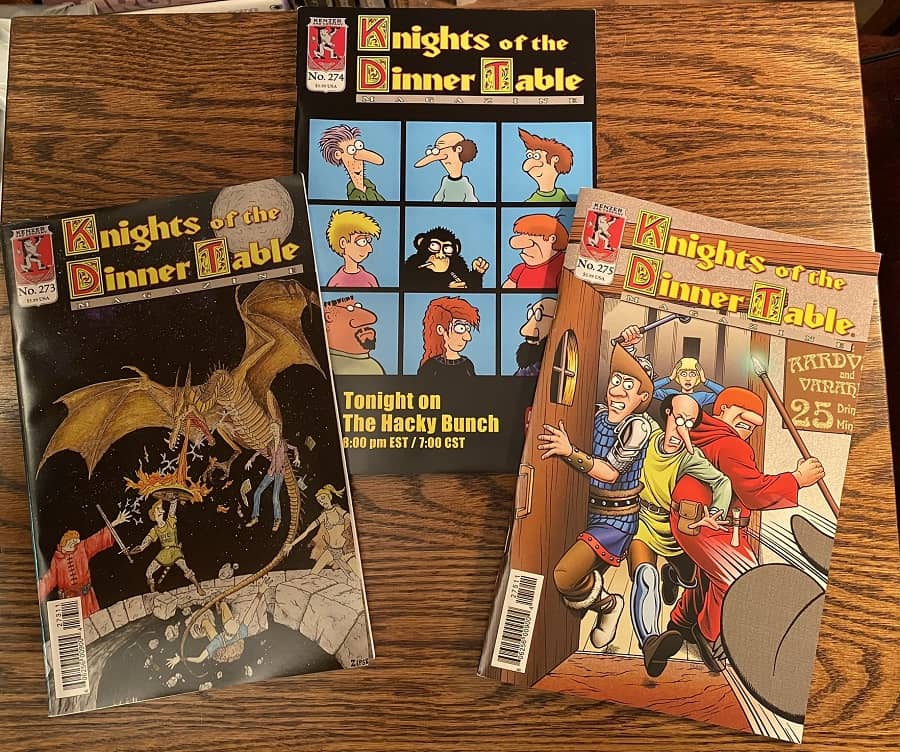
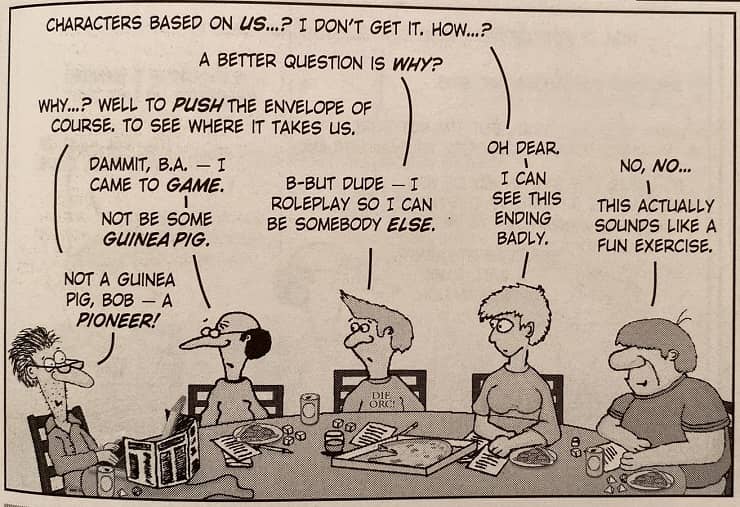
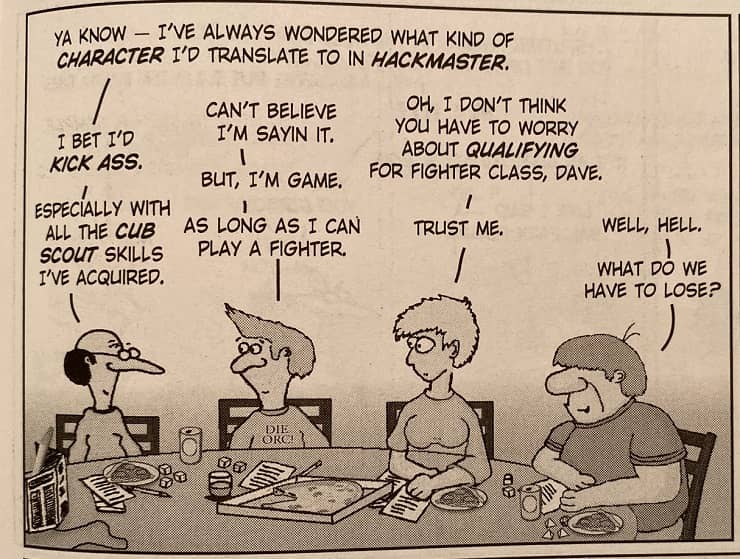
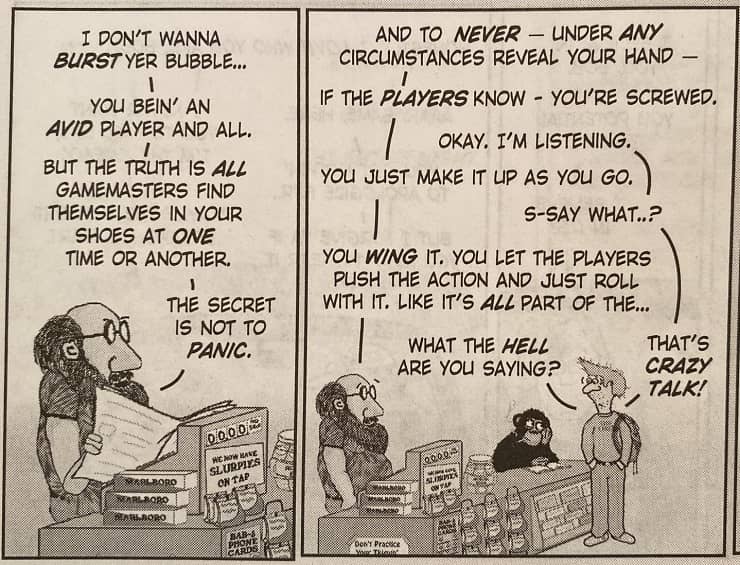
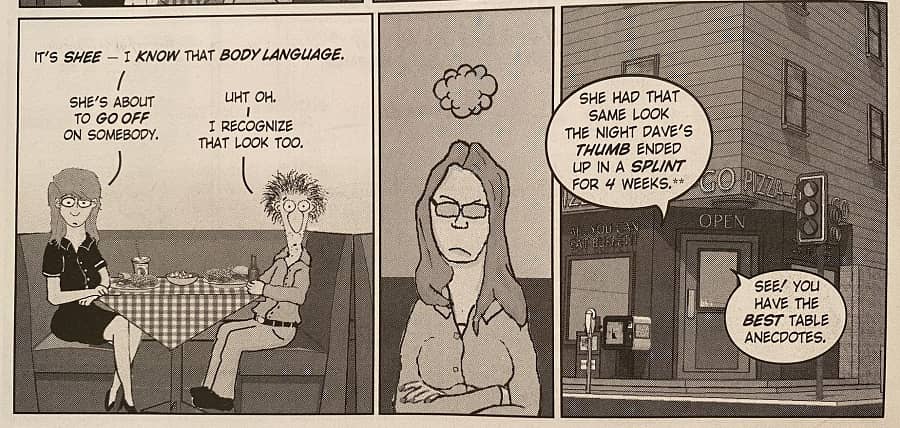
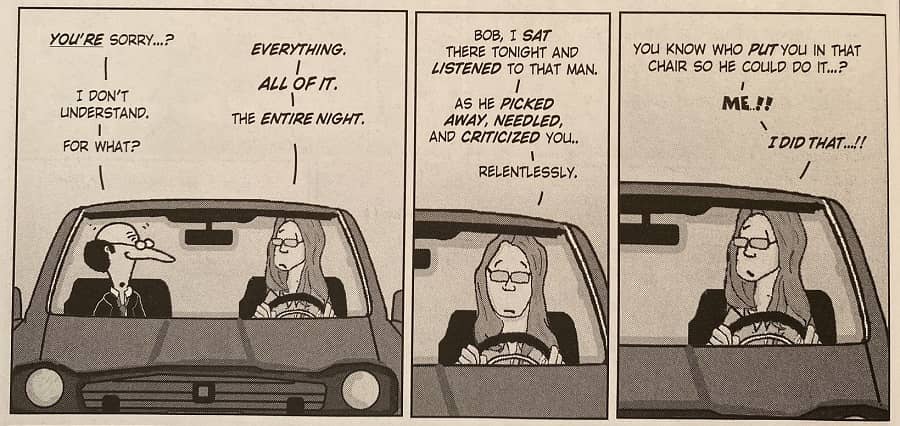
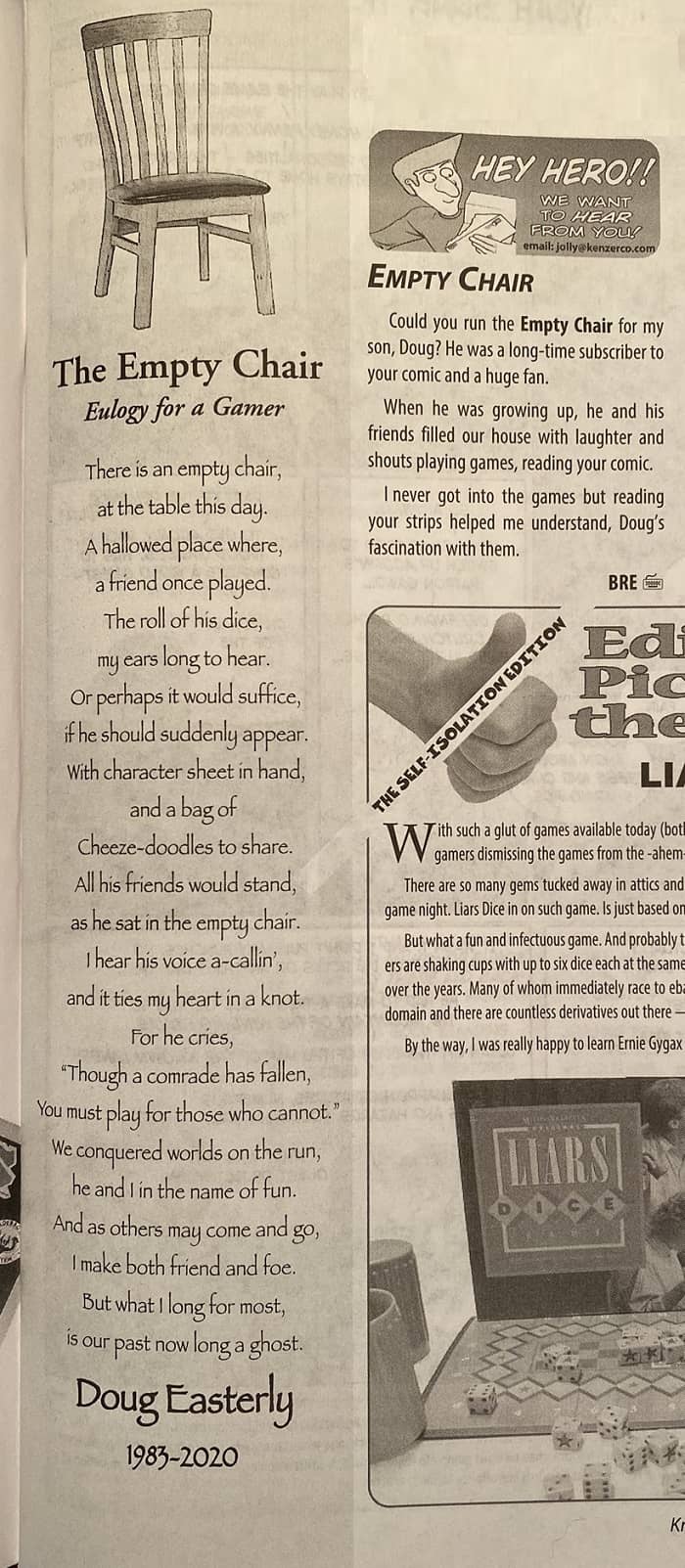
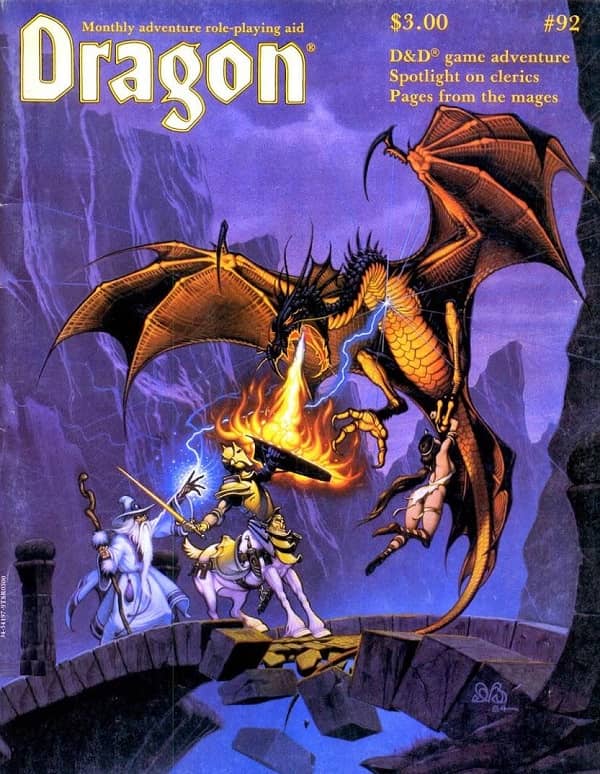
Congrats to Mr. Blackburn for keeping the flame of Knights of the Dinner Table burning bright, lo these many years since 1990! The Empty Chair is a terribly kind gesture, reminding me of the memorial moment in every sf Worldcon Hugo ceremony that “roll calls” the people lost since the previous Hugo awards.
Boy, I miss Shadis! I drifted away towards the end as AEG got more into collectible card games, but I still enjoyed its independent look at gaming and gaming culture, much like another print magazine from “back in the day”, Back Gate(?) or something like that.
Glad to see Kenzer and Co have survived this years challenges. I must make an effort to pick up some of the newer KODT magazines. Loved KILL as well, was sad when that came to an end.
I was an intern for Kenzer 20 years ago. I’m glad to see they’re still going strong.
What was it like Dave? Working for a game etc publisher? I remember fantasising about working for a game company as a young teenager; playing games for a living and being paid for it etc. I bet the reality was quite different?
> Boy, I miss Shadis! I drifted away towards the end as AEG got more into collectible
> card games, but I still enjoyed its independent look at gaming and gaming culture
Eugene,
Me too. I didn’t discover it until the early 90s, and when I ordered some back issues, they arrived with a hand-written thank you note from someone name Jolly Blackburn (which I still have). It was a truly great gaming mag with an old-school flavor I really enjoyed.
> much like another print magazine from “back in the day”, Back Gate(?) or something like that.
🙂 Believe it or not, KenzerCo used to distribute Black Gate to the gaming market in those days.
I’ve told the story of how I met founder Dave Kenzer (he was four doors down the hall from me at Motorola — we both had day jobs in the Schaumburg office) a few times, most recently in the intro to the collected Java Joint strips, which appeared in the back of every issue of the print version of BG.
https://www.blackgate.com/2012/04/03/knights-of-the-dinner-table-the-java-joint-strips/
> Loved KILL as well, was sad when that came to an end.
Tony,
Knights of the Dinner Table Illustrated was a simple and daring idea — a fantasy comic illustrating some of the Knights most famous adventures. It lasted for 41 issues and built up quite an audience — not bad at all for an independent comic!
> I was an intern for Kenzer 20 years ago. I’m glad to see they’re still going strong.
Dave,
I had no idea! Was that in their Waukegan offices?
We must have met a few times — I used to drop by there all the time, and even attended their Christmas parties. I met most of the team, including Jiffy, Dwarf, and Noah Chinn. It was a fantastic group.
When I worked there, their office was in Lake Zurich. This was in the year 2000, right when 3rd edition D&D had come out and about a year before the release of the HackMaster RPG. John, if you were at the 2000 Christmas party, we most likely met.
Tony, “playing games for a living and being paid for it” is inaccurate as far as the “living” part. At least it paid something, which is better than a lot of internships. There wasn’t much gaming during the day, but after hours sometimes we’d playtest modules. One of my main duties was to go through every issue of KODT and make note of every magical item mentioned, so they would be included in the HackMaster RPG. Other times I’d be doing normal stuff like driving boxes of comics from their old warehouse to the new one. Overall it was a great job, and one of the few I ever had that I liked.
Man what memories this triggered!
Shadis? God, such a great, underappreciated mag!
Hackmaster? Everything awful about chart-heavy, old-school gaming — and yet in so many ways such a relief after a decade of angst-ridden, hyper-pretentious gaming (looking at you White Wolf).
And KoftDT? Well, to quote that great Shaman, Greg Stafford, “We are all Us.”
Thanks for this, John. It really made me smile.
Oh, and I immediately remembered that copy of Dragon 92 — still have it, I suspect.
> When I worked there, their office was in Lake Zurich. This was in the year 2000,
> right when 3rd edition D&D had come out and about a year before the release of the
> HackMaster RPG. John, if you were at the 2000 Christmas party, we most likely met.
Dave,
It’s possible… I met Dave Kenzer at Motorola in 1997 and (three years later, when I finally figured out he was the same Dave Kenzer who published one of my favorite comics) started writing a regular review column for KoDT in December 1999. My first review appeared in issue #40, published February 2000. I’m pretty sure I attended the KenzerCo Christmas party in 1999 or 2000, and I know I visited their Lake Zurich offices half a dozen times.
I also contributed to the first release of Hackmaster. I wrote the Smartass Smackdown Table (and all the supporting text) one afternoon at Motorola while Dave and I were waiting for a meeting to get started. That was a lot of fun.
No idea you had a history with KenzerCo. Small world! That was right around the time KenzerCo was distributing Black Gate to the gaming market. Did you ever see the mag back then?
> Shadis? God, such a great, underappreciated mag!
Greg,
Hear! Hear! A marvelous, underappreciated magazine. On top of all the great content, it had a huge number of ads from small press and indie publishers who couldn’t afford to advertise in Dragon.
I used to feel really connected to the gaming scene when I read Shadis. I still miss it.
Came across this via it’s mention in the (free atm in PDF) KODT #277. Jolly said in it “I’ll be honest, John O’Neill’s piece made me cry.”
And dammit you got me too. Great write up.
Joshua — thanks so much! I had no idea that Jolly had commented on this old article in KODT.
The free PDF download for #277 of Jolly’s Knights of the Dinner Table is here:
https://kenzerco.com/product/knights-of-the-dinner-table-277/
and I found this letter and Jolly’s response in the Letters section: